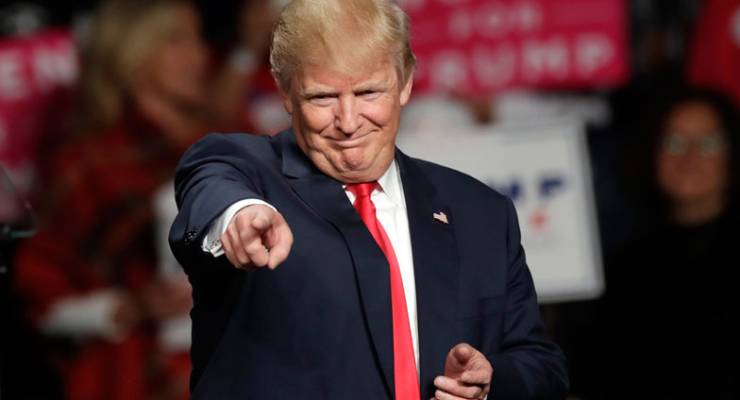
Generals, it’s famously said, are always ready to fight the last war. The same goes for journalists.
The US media’s misreading of the 2016 presidential election (echoed in Australia’s 2019 election) has driven an eagerness to get right what went wrong, as readers ask: can we trust the media this time around?
The angst about 2016 is not because journalists got the horse-race wrong. It was because they missed the bigger story of the fundamental social shifts. After drawing some lessons, journalism has accelerated the evolution from old-fashioned stenographic reporting to a more deeply analytical journalism of context.
What are those lessons? And what does that mean for Australia?
The polls aren’t everything
Journalists like to think they bring a gut-checking reality to the polls. Turns out, the gut-check was just confirmation bias. In both 2016 and 2019, the polls created and reinforced perception.
In the US, the media have since strengthened specialist data units like The Upshot at The New York Times and FiveThirtyEight headed by Nate Silver (now part of Disney’s ABC). These provide polling averages that take into account the accuracy of different pollsters. For the more nervous readers, The Upshot provides a table adjusting polls by both the 2016 and the 2012 error.
In Australia, this analysis remains anchored in its academic and blogging roots, such as occasional Crikey contributor William Bowe, while News Corp continues to report its Newspoll results much as it’s ever done.
Society is diverse — but the media isn’t
Immediately following the 2016 election, the big city US media was criticised for overlooking “the economic anxiety” of the so-called “white working class” — older, regional voters in the mid-west rust belt. Australia’s media copped the same criticism for missing the shift in Queensland regional seats last year.
The post-election joke was that The New York Times decided to profile every mid-west road-side diner to find out what they missed. But, the post-election ruminations crashed into two big social moments: Me Too and Black Lives Matter.
The lesson for the media? US elections turned out to be decided by a whole lot of social groups affected by different issues moving in different elections. Yes, older, less-educated men in regions were moving right. But college-educated women in the suburbs were moving left.
This forced the US media to rethink its own diversity, in the stories it covers and the journalists it employs. There’s now a deeper understanding that systemic racism and sexism have social, political and media consequences. However, in Australia that understanding lags.
All politics is local
In both the US and Australia, different regions and states are like tectonic plates crashing into each other triggering earthquakes. We know that so much of this can be missed without strong local reporting but, in both countries, the collapse of the business model has left local media weaker.
The result? Politics is still local — but too often hidden away in closed Facebook groups, narrowing debate, leaving fake news uncontested.
Don’t take the bait
Remember when Donald Trump could trigger a media tsunami with nothing more than a well-placed tweet? The hardest lesson for the US media has been: just because the president says it, doesn’t make it news. It’s still a work in progress.
Scott Morrison has always had to work harder for attention, although Australia’s media is struggling to learn that substance makes the announcement, not the other way around.
But her emails…
Every leak has a political motivation. That should make journalists more sceptical, not less. Yet through the 2016 election, the drama of leaks and the false scandal of Hillary Clinton’s emails created a theatre which few journalists could resist.
Blame Watergate: every scandal looks like it should destroy a presidency.
Now, not so much. Despite the efforts of Trump allies and News Corp to build up a Joe Biden email scandal, most of the media have wised up.
And a touch of humility
The most valuable lesson has been humility. While many are eager for reassurance right now, US journalists have been reporting with analysis, context and plenty of uncertainty. That’s a lesson that wouldn’t be lost in Australia.








Christopher, the median Australian is presently a 38 year-old woman with an annual income of around $48,000. If the US Presidential election doesn’t directly change any decisions she makes about her life, then neither does Australia’s reporting about it.
She’s unlikely to be speculating in greenbacks; if she’s working at all just now there’s a good chance it’s in some service industry and not trying to export minerals, agriculture or tourism; and between Covid and the exchange rate she’s unlikely to be visiting Walt Disney World in Florida in the next 18 months.
All of which means that aside from a few financiers, exporters and expats, the outcome of the US presidential election requires no great speculation here. Australian journalists trying to predict this outcome are mostly trying to impress and humiliate one another, and the journals vying for prescience about it are doing so for rather cynical commercial reasons.
Perhaps of more use would be speculation about the US economic recovery and its impact on Australian jobs.
Biden may take the virus more seriously, but it is so extensive in the US that he will not be able to roll it back or even contain it if he is elected. It is too late.
Don’t get me started on the Australian ‘medium’ of culturally specific ‘journalists’, politicians and business informing each other on daily politics; it’s all about commentary and talk within shorter time frames round political (free) PR content prvided by politics.
Creates a need for taking heuristic short cuts by citing cliches, sound bites, personalities etc. vs. investigation and understanding. In turn this makes the electorate and nation more ignorant through omission of issues and lack of understanding of the same, not covered by media.
An excellent metaphor is ABC Insiders (NYCU Prof. of journalism Jay Rosen cited as an example of what’s wrong i.e. the name, suggests they are all friends and close to MPs) followed by Offsiders.
If you are not paying attention they could be interchangeable with focus and questions on specific events but not much context (while Waleed Aly is deemed competent to be a guest on Offsiders but not Insiders, because he is not culturally ‘inside’ enough?).
The ever thinnning ranks of Australian journalists need to be careful they are not doing the bidding of power in media, LNP, related right wing politics and similar influencers so that the LNP or the right become like the GOP, white Christian nationalists. Meanwhile journalists have been unwittingly nudged to the right…..
Insiders can offer useful analysis, Drew, and not everyone on the panel are friends, however I agree that there’s something wrong with politics being so rarified that you have to be an insider to understand it, and (per my earlier comment) of journalists being more interested in each others’ opinions than they in the needs of the readers they claim to serve.
If the name were changed to INCITERS or even INSIGHTERS it would require the couchees to up their game.
Most corporate media in the US is still very duplicitous, they are just less gullible as far as Trump is concerned – at least those outlets that are ‘against’ him. Other then that, they are still mouthpieces for power. And whilst Fox has a large audience and the other large media players are at least pushing back, so you could say some more diversity or attempts to balance out the partisan viewpoint in terms of political parties, it’s still in service of corporate power.
As for Australian corporate media, they largely align with the conservative side of politics and I don’t see them learning any lessons because everything is going quite swimmingly. Morrison isn’t as crude as Trump, so no need.
One only has to point to the overt “annoyance” from corporate journalists with regards to the “twitterati” who keep pushing back on their BS, insisting they perform ‘excellent’ journalism. It clearly bothers them, and whilst some are trying to be reflective, they keep missing the major points.
Trump’s use of Twitter in one fell swoop removed that corrupt MSM from the US oligarchy.
A policy master stroke by a political genius., equaled only by the Kremlin’s decision to launch RT.
You need to understand the meaning of that term –
Fell here is an adjective meaning fierce, savage, cruel, or ruthless. This sense of fell is otherwise archaic, preserved mainly in this idiom.
If you say so……
And I upvoted your comment cos it’s clear you desperately need approval….from anyone, I expect.
When you start embellishing the news – rather than stick to just reporting it – you’re bound to stray over the lines with your crayons.
That one only took 3 logins too.
And when you finally get there and type your comment, hit Post Comment and get a red message saying ”Some of field value is invalid”. Then copy the text, log out, log in again, paste the text and it goes through. The IT at Croaking is stuffed.
It’s not as if this plain fact is unknown – it has been flagged by many commenters.
Apparently, they just don’t care/can’t be arsed to do anything to rectify it.